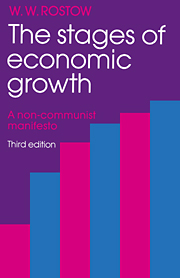Book contents
- Frontmatter
- Contents
- Preface to the Third Edition
- Preface to the Second Edition
- Preface to the First Edition
- 1 INTRODUCTION
- 2 THE FIVE STAGES-OF-GROWTH—A SUMMARY
- 3 THE PRECONDITIONS FOR TAKE-OFF
- 4 THE TAKE-OFF
- 5 THE DRIVE TO MATURITY
- 6 THE AGE OF HIGH MASS-CONSUMPTION
- 7 RUSSIAN AND AMERICAN GROWTH
- 8 RELATIVE STAGES-OF-GROWTH AND AGGRESSION
- 9 THE RELATIVE STAGES-OF-GROWTH AND THE PROBLEM OF PEACE
- 10 MARXISM, COMMUNISM, AND THE STAGES-OF-GROWTH
- Appendix A THE DIFFUSION OF THE PRIVATE AUTOMOBILE
- Appendix B THE CRITICS AND THE EVIDENCE
- Coda: REFLECTIONS ON THE DEBATE AS OF 1990
- Acknowledgments
- Index
7 - RUSSIAN AND AMERICAN GROWTH
Published online by Cambridge University Press: 05 June 2012
- Frontmatter
- Contents
- Preface to the Third Edition
- Preface to the Second Edition
- Preface to the First Edition
- 1 INTRODUCTION
- 2 THE FIVE STAGES-OF-GROWTH—A SUMMARY
- 3 THE PRECONDITIONS FOR TAKE-OFF
- 4 THE TAKE-OFF
- 5 THE DRIVE TO MATURITY
- 6 THE AGE OF HIGH MASS-CONSUMPTION
- 7 RUSSIAN AND AMERICAN GROWTH
- 8 RELATIVE STAGES-OF-GROWTH AND AGGRESSION
- 9 THE RELATIVE STAGES-OF-GROWTH AND THE PROBLEM OF PEACE
- 10 MARXISM, COMMUNISM, AND THE STAGES-OF-GROWTH
- Appendix A THE DIFFUSION OF THE PRIVATE AUTOMOBILE
- Appendix B THE CRITICS AND THE EVIDENCE
- Coda: REFLECTIONS ON THE DEBATE AS OF 1990
- Acknowledgments
- Index
Summary
A REMARKABLE PARALLEL
Before turning, in chapters 8 and 9, to the relevance of the stages-of-growth to issues of war and peace, it may be useful to examine briefly a matter of both historical and contemporary interest: the nature and meaning of the relative paths of growth of Russia and the United States.
When we think journalistically of Russian economic development a number of images may come to mind: an image of a nation surging, under Communism, into a long-delayed status as an industrial power of the first order—symbolized by the Russian success in launching the first earth and solar satellites; an image of a pace of industrial growth unique in modern experience, held at forced draught by a system of state controls that constrains consumption, maintains unexampled rates of investment, and avoids lapses from full employment; an image of a planned economy so different in its method and institutions as to require forms of analysis different from those applicable in the West. In short, the conventional image is of a story apart.
There are, of course, profound special elements in the story of the evolution of modern Russian society and of its economy; and, before we finish, we shall try to identify the nature of its uniqueness. But the first point to grasp is that Russian economic development over the past century is remarkably similar to that of the United States, with a lag of about thirty-five years in the level of industrial output and a lag of about a half-century in per capita output in industry.
- Type
- Chapter
- Information
- The Stages of Economic GrowthA Non-Communist Manifesto, pp. 93 - 105Publisher: Cambridge University PressPrint publication year: 1991



